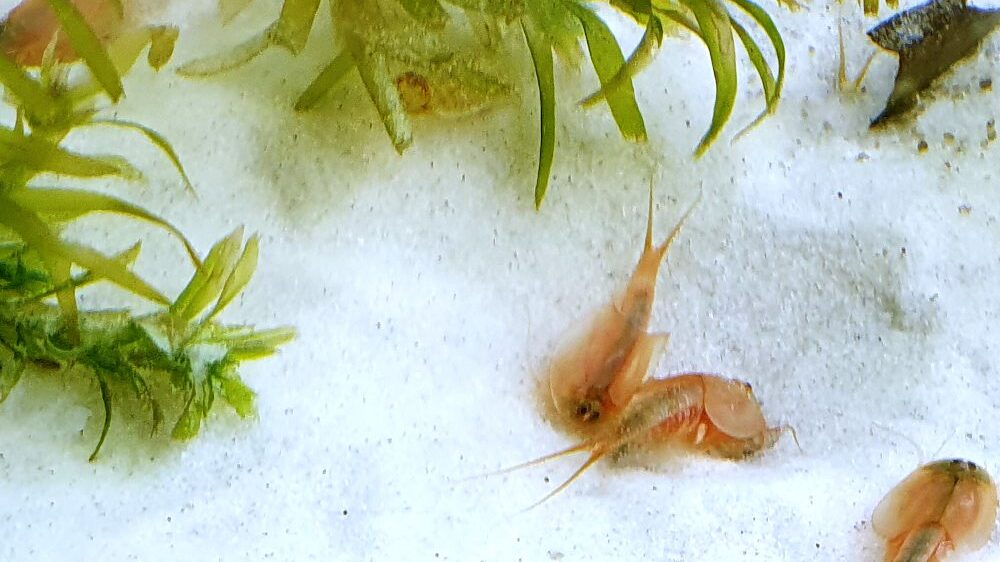Guide
Substrate in a Triops aquarium: what to consider when choosing sand
In addition to the right aquarium technology, the substrate is also crucial for the optimal breeding of Triops. This plays a key role in the well-being of the prehistoric crustaceans, as they are passionate diggers and need plenty of sand to satisfy their natural instinct. During the breeding phase, no special considerations need to be made regarding the sand, as a mixture of eggs and sand is sufficient for the breeding batch and no additional sand is required. Only when the Triops are transferred to a larger tank or aquarium should the substrate be adjusted accordingly. Not only is the biological balance in the aquarium important here, but also the avoidance of injuries to the Triops. In this blog article, I explain what is important when selecting the substrate for breeding Triops.

Substrate in the Triops aquarium: Not every substrate is suitable
As soon as our Triops are about one centimetre in size – which is usually after about ten days – it is time to move them to a larger tank or aquarium. But before we make this move, we need to make sure that the substrate for breeding Triops is carefully selected to provide the best possible environment for the little prehistoric crustaceans to thrive. Not every substrate is suitable for breeding Triops, as sand that is too coarse or sharp objects can harm the sensitive animals.
Triops are naturally keen diggers and lay their eggs in the sand once they reach sexual maturity. They also search for food in the sand and burrow into it. It is therefore important to ensure that the substrate is of an appropriate height when setting up the aquarium – at least one centimetre, but ideally three to four centimetres. This way, the Triops have enough sand to dig in to fulfil their natural needs and lay eggs.
Soil granulate and quartz sand
It is important that the sand does not have any sharp edges, and sharp objects or stones should also be avoided as decoration. The sand should be sieved several times, thoroughly washed, free of lime and germs, pH-neutral and free of organic impurities. Soil granulate is also a good choice for many plants in the aquarium, as it enables better plant growth through natural nutrients. Both aquarium gravel and aquarium sand can be used. Quartz sand or sandpit sand can also be used.
Light or dark sand?
When selecting the optimum sand for the Triops, we can choose between aquarium sand and aquarium gravel. Although they are similar, the fundamental difference between sand and gravel is their density. Compared to gravel, the spaces between the sand particles are smaller. This has the advantage that dirt particles can penetrate less easily, which helps to maintain the natural balance in the aquarium. The colour of the sand has no direct influence on breeding, but can make the aquarium more visually appealing. Both natural white sand and darker sand types are suitable. Light-coloured substrate brings out the best in darker Triops species such as Triops granarius and Triops cancriformis. In addition, light-coloured sand makes it easier to see algae and dirt. The sand should be finely sanded and have a grain size of less than one millimetre, as too coarse a grain size can be an obstacle to the Triops digging and laying their eggs.
Substrate in the Triops aquarium – Conclusion
Overall, the selection of the right substrate in the Triops aquarium is of crucial importance for the well-being and health of the Triops. A suitable substrate allows the Triops to pursue their natural behaviours, such as digging and egg laying, while at the same time supporting the biological balance in the aquarium.
When selecting the substrate, it is important to look for fine sand without sharp edges and impurities. An appropriate grain size and sufficient height of the substrate are also crucial to provide the Triops with optimal conditions.
In addition, the colour of the substrate can influence the appearance of the aquarium and make certain Triops species stand out better. A light-coloured substrate also makes it easier to see algae and dirt.
Overall, the careful selection and care of the substrate helps to ensure that the Triops feel comfortable in their habitat and remain healthy.
- Osmosis water in the aquarium: A guide for aquarium enthusiasts - 5. May 2024
- Vietnam: Hundreds of thousands of fish die due to drought and heat - 3. May 2024
- Introduction to the basics of ichthyology - 28. April 2024